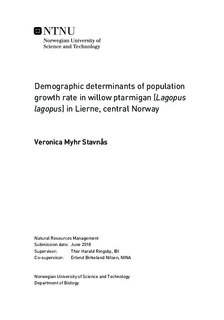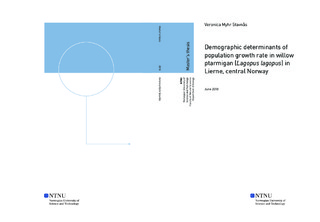| dc.description.abstract | Willow ptarmigan (Lagopus lagopus) populations in Norway have declined during the last decade and the species was included in the Norwegian Red list in 2015 as near threatened . Accordingly, it is important to identify the drivers of the population decline, which possibly may lead to management mitigations that may increase the viability of the population. This 3-year study presents insight into both recruitment rate and survival rate, and identifies the demographic determinants of the population growth rate (λ) in a willow ptarmigan population in Lierne, central Norway. Radio-telemetry was used to estimate adult survival and cause-specific mortality probabilities, and camera traps on nests were used to estimate breeding success. In addition, line transect surveys was applied to estimate population densities and brood size in autumn. The combined use of these data presents a novel method providing vital estimates on all steps of the life cycle. A stage-structured projection matrix was constructed to calculate sensitivities and elasticities of λ to the demographic parameters. As expected for a fast-living species, the willow ptarmigan population exhibited high reproductive potential and low adult survival. All hatching failures were due to predation. The adult mortality rate was highly influenced by predation and harvest, and the estimated probability of mortality owing to predation and harvest was 0.40 and 0.28, respectively. Juvenile survival during summer and autumn, and hatch probability were identified to have potentially largest impact on λ. Further, the elasticity of λ to recruitment was higher than to adult survival. The observed population growth was positive (λ = 1.20) and might be explained by immigrating individuals rather than the demography of the population. Based on the elasticity analysis and the estimated harvest rate, this study suggests that management actions including a reduction in the harvest rate would have a substantial positive effect on λ. | |

